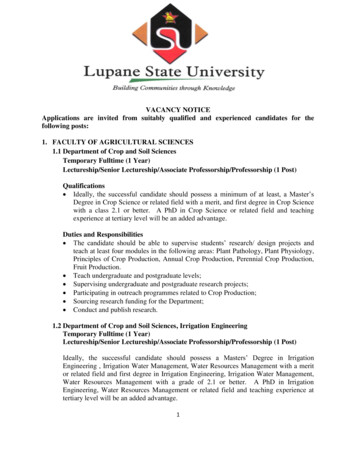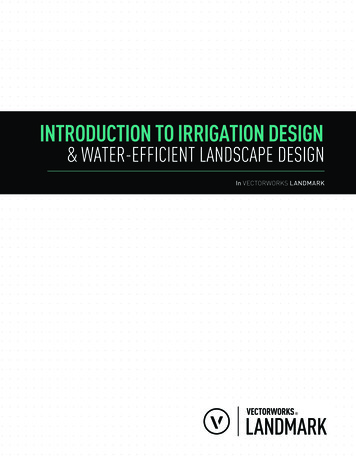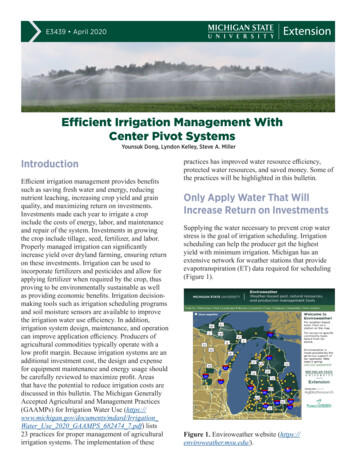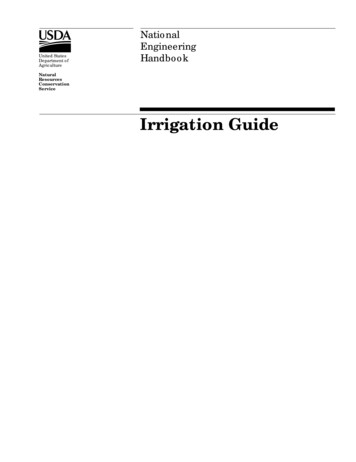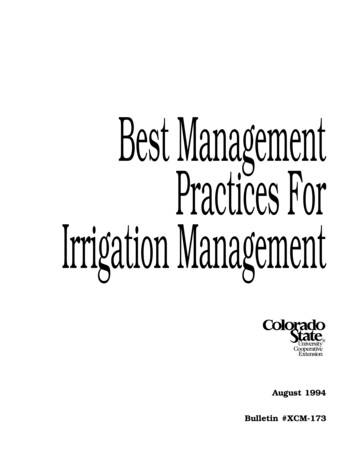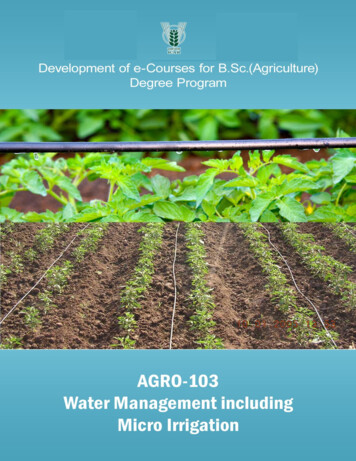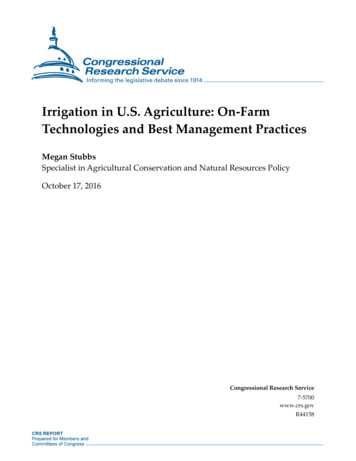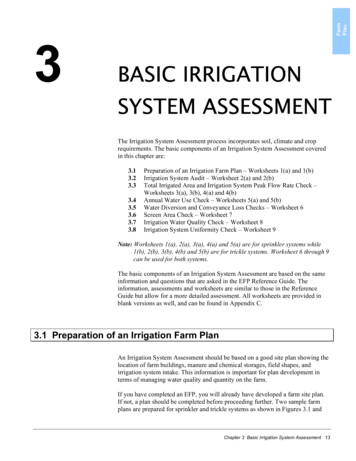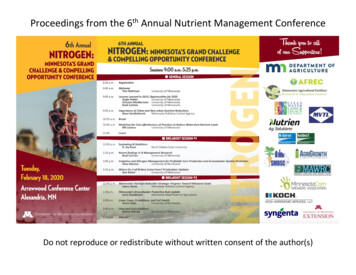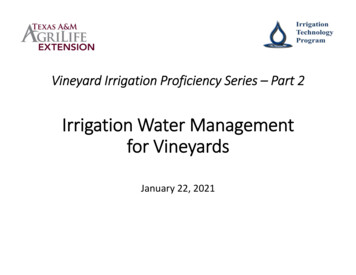
Transcription
Vineyard Irrigation Proficiency Series – Part 2Irrigation Water Managementfor VineyardsJanuary 22, 2021
Agenda Introduction to Evapotranspiration Concepts Calculating Irrigation Runtimes Overview of Soil Moisture Sensor Technologies Installation and Management of Soil MoistureSensors
What is “ET”?
Evapotranspiration, ET Measurement of the total requirements of plantsand crops The word evapotranspiration is a combination ofthe words “evaporation” and “transpiration” Very difficult to measure directly May be calculated using weather data
ET Weather Station
ET Theory and Current Practice Penman 1949 first proposed the “energy balancemethod” for determining plant water requirements This method required daily or hourly weather data:solar radiation, temperature, wind, and relativehumidity ET is calculated for a single plant/crop which is usedas a reference for determining the waterrequirements of all other plants/crop
Reference Evapotranspiration, ETo Alfalfa was the first reference crop used A cool season grass is now the standard referenceplant The reference cool season grass is similar to afescue, except that it is growing under ideaconditions
Reference Evapotranspiration, ETo Also is called the “Potential ET (PET) Used as a reference from which the waterrequirements of all other plants can be determined Note: ETo PET ETo is the potential evapotranspiration (PET) of acool season reference grass growing 4‐inches tallunder well watered conditions
Reference Evapotranspiration, ETo ETo for Central/North Texas usually peaks in Julybetween 0.24 and 0.28 inches per day Lubbock: peak ETo 0.33 – 0.36 in/day El Paso: peak ETo 0.5 – 0.6 in/day
Crop Coefficient (Kc) Crop coefficients (Kc) are used to relate ETo to thewater requirements of specific plants and crops Crop coefficients also change depending on thegrowth stage of the crop
Crop Coefficient (Kc) Examples, at peak water use, the Kc of somecommon crops are: Corn: Kc 1.3Cotton: Kc 1.0Sorghum: Kc 1.10Warm Season Turf: Kc 0.6
Crop Coefficient (Kc) What is the peak Kc for wine grapes? Wine Grapes: Kc 0.8 (from California) FAO Coefficient – Wine Grapes Initial 0.3Rapid Growth 0.5Mid Season 0.7Late Season 0.57Harvest 0.45
Crop Coefficients University of Washington Wine Grape Study
Water RequirementsExample, what is the peak water requirements (ET)for corn in Central Texas? ETcorn ETo x Kc ETcorn 0.28 in/day x 1.3 ETcorn 0.35 in/day
Water RequirementsExample 2, what are the daily and weekly peak waterrequirements (ET) for grapes in Central Texas?Daily ETgrape ETo x Kc ETgrape 0.28 in/day x 0.8 ETgrape 0.22 in/day
Water RequirementsExample 2, what are the daily and weekly peak waterrequirements (ET) for grapes in Central Texas?Weekly ETgrape ETo x 7 days x Kc ETgrape 0.28 in/day x 7 days/week x 0.8 ETgrape 1.98 in/week x 0.8 ETgrape 1.57 in/week
Irrigation System Runtime Precipitation Rate ‐ measurement in inches perhour of how fast an irrigation system applies water
Precipitation Rate (in/hr) PR Precipitation Rate, in/hr GPM Total Flow in gallons per minute Area wetted area in ft2
Total Flow Measured directly with flow meter Estimated based on irrigation system design Total of all the drip emitters used
Wetted Area Based on: Grape row width, or Total Area of the field Influenced by root zone area Will roots spread out over timebetween rows of grapes?*Note: 1 Acre 43,560 ft2
Example Wine Grape Rootzone
Irrigation System Runtime RT – Station Runtime (hours) WR – Water Requirement (inches) PR – Precipitation Rate (inches per hour)
Irrigation System RuntimeExample: My drip irrigation system has aprecipitation rate of 0.5 in/hr. How long will theirrigation set be to meet peak weekly waterrequirements of 1.57 in/week? RT WR/PR RT 1.57/ 0.5 RT 3.14 hours or 189 minutes
Web site demonstrationhttp://TexasET.tamu.edu
Irrigation SchedulingWorksheet
Irrigation ControllerManagement
Irrigation Controller Management Irrigation Controllers Can incorporate weather sensors Such as for ET Calculation/Estimation Use of Rain Sensors Avoid Irrigating during rain events Incorporate total rainfall into schedule Use of Soil Moisture sensors Flow monitoring Remote Control WiFi or Cellular access for controller programming andoperation
Rain Sensors Also called Rain Shut‐off Device or Rain Switch Designed to interrupt a scheduled cycle of anautomatic irrigation controller (timer device) whena certain amount of rainfall has occurred. 3 Models: Utilize a receptacle to weigh the amount of water Tipping Buckets Utilize a receptacle to detect the water level Use of a hygroscopic expanding material to sense theamount of rainfall Most widely used method
Rain Sensors Rain Sensor(Rain Shutoff Device) Tipping Bucket
Rain Sensors Can delay irrigation until the sensor “drys out” Some controllers can have a programmed timed delay(such as 48 hours) once a sensor is triggered to avoid thesensor re‐activating too soon Can contain an internal tipping bucket that measuresthe amount of rainfall to adjust the water balance
Soil MoistureManagement
Soil Moisture Management The concept is to: wait to irrigate until the plants have depleted the waterin the root zone Run the irrigation system just long enough to fill back upthe root zone
Definitions used in Soil MoistureManagement Plant Available Water (PAW) The amount of water in the root zone available for plantuptake Soil Water Holding Capacity (SWHC) The amount of water that can be held or stored in thesoil Managed Allowable depletion (MAD) How dry the soil is allowed to become betweenirrigations (50% for most plants)
Soil Water Holding Capacity Demonstration Video
SoilsTypical Water Holding Capacity (inches of water per foot of soil)SoilTextureAt FieldCapacityAtPermanentWilting PointSoil WaterPlant AvailableHolding Capacity Water(@ MAD 50%)Sand1.0-1.40.2-0.40.8-1.00.45Sandy -1.80.85Silt Loam2.7-3.11.0-1.21.7-1.90.90Clay -2.21.05
Plant Available WaterPAW D x SWHC x MAD PAW Plant Available Water in root zone (inches) D Root Zone Depth (feet) about 3 feet for grapes unless limited by shallow soils SWHC Soil Water Holding Capacity Inches of water per foot of soil MAD Managed Allowable Depletion 50% for most crops, some use 65% for grapes
Soil Moisture SensorTechnology
Soil Moisture Sensor‐BasedControllers Soil Moisture Sensor‐Based Controllers function in2 ways: Provide Closed Loop Feedback Similar to a home AC thermostat Most Common Method Give direct feedback to a controller Large Central Control – Controller Technology Allows for direct irrigation on demand
Soil Moisture Based Systems 2 Major Categories of Soil Moisture Sensors Soil Water Content (Volumetric) A sensor that measures volumetric content of water in avolume of soil, % Soil Water Tension A Sensor that measures the matric potential of water held inthe soil Sometimes referred to as Soil Water Potential or Soil MatricPotential The force with which water is held by the soil matrix (soilparticles and pore space)
Soil Moisture Sensor Operation Typically take the place of Rain Sensors onControllers Use of Sensor Ports or in Series with Common Wire/Port Operate by opening the circuit until the soilmoisture content reaches a programmed deficit atwhich point the circuit is closed and the controllercan begin its scheduled irrigation until the circuit isopened again. Most controllers will still require setting irrigationruntime, frequency, etc.
Using Soil Moisture Sensors Installing Multiple Sensors at Multiple Depthsimproves accuracy. Depth of Placement should be representative ofthe effective root zone. Difficult to obtain accurate readings in the top 2inches of soil
Using Soil Moisture Sensors Can be expensive and challenging to use in large orelaborate landscapes/fields Finding a representative to install location within theirrigation system Often different plant materials will require their ownsensors Changes in Soil type Different root zone depth Irrigating grapes & grass?
Types of Soil Moisture Sensors Granular Matrix Sensor Gypsum Blocks Tensiometer Capacitance Probe Time Domain Transmissometry, TDT Time Domain Reflectometry, TDR Frequency Domain Reflectrometry, FDR
Soil Moisture Sensor Technologies Most Commonly Used in Field Irrigation Granular Matrix Capacitance TDR/TDT
Granular Matrix Sensors Contain a set of electrodes in a granular matrixmaterial (combination of quartz & gypsum) Changes in soil electrical conductivity (resistance)are correlate to soil matric potential i.e. the suction head as the soil wets and dries
Reading Water Potential Available Water varies inthe soil based on the matricpotential (soil suction) Graph shows typicalrelationship of soil suction toavailable water depletion Most SMS products willsimplify the range a sensorreads for irrigation mgmt. Such as 1‐10 threshold scale
Capacitance Sensors Capacitance: the ability to hold an electric charge –of the surrounding soil in order to obtain thedielectric permittivity of the soil Sensor determines the dielectric constant (Ka) bymeasuring the charge time of the capacitor, usingthe soil as the dielectric medium Since Ka of Air 1 and Water 80, the capacitor uses alinear function to determine the dielectric permittivityof the soil
TDR/TDT TDR & TDT are similar in operation Operate using an electromagnetic wave passedthrough the soil via parallel rods from atransmission line. With TDR, the speed and strength of the wave after ittravels from one rod to another is directly related to thedielectric properties (soil moisture content) of the soil With TDT, the rod is connected to the electrical source atthe beginning and end of the rod to measure the traveltime of the wave between rods
Sensor Technology bly)SensitivetoSalinityAffected ghGranularMatrix
Sensor Calibration All sensors require calibration based on sensor type Most manufacturers have simplified calibration forsensors used with landscape irrigation controllers Calibration by:Soil Type,User Defined Threshold, orTimed Calibration by irrigating the site to fieldcapacity/saturation
Examples of Irrigation Sensors
Using Soil MoistureSensors
Equipment ‐ Sensors Watermark Sensor InexpensiveEasy to useNo maintenanceWill not dissolve in soil
Sensor Installation Can be installed using astandard 5/8” soil probe Installing at multiple depthprovides for best soilwater management Typically installed at 1ft,2ft & 3ft depths dependingon depth of root system.
Equipment ‐ Meter Watermark MeterQuick and Easy to useInexpensiveDurableReads Soil Tensionin CBARS Need to reference a chart to determine soil moisturethreshold
Defining the Threshold Soil Water Tension (CBARS)varies based on soil type. Water threshold is usuallydefined as 50% AvailableWater Depletion Simply Determine SoilSuction for your soil. Ex. Loam @ 50% 84 CBARS
Preparing Soil MoistureSensors VideoDemonstration
Installing Soil MoistureSensors VideoDemonstration
Reading Soil MoistureSensors VideoDemonstration
Interpreting SoilMoisture SensorReadings
Interpreting Sensor Readings Graphing sensor readings will help create a visual ofmoisture conditions in the soil Trends of moisture at each sensor level Effectiveness of rainfall events Do you need to irrigate after rain? Adequacy of irrigation events Are you irrigating too frequently? Are you applying enough irrigation to refill the root zone?
Demonstration Data
Demonstration Data
Example Vineyard Sensor Data
Contact Information Dr Guy Fipps, PEProfessor & Extension Ag Engineerg‐fipps@tamu.edu Charles SwansonExtension Program Specialist IIclswanson@tamu.edu979‐845‐5614
Irrigation System Runtime Example: My drip irrigation system has a precipitation rate of 0.5 in/hr. How long will the irrigation set be to meet peak weekly water requirements of 1.57 in/week? RT WR/PR RT 1.57/ 0.5 RT 3.14 hours or 189 minutes
